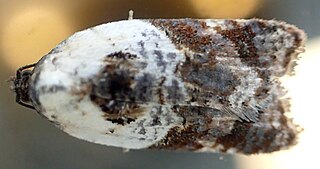
Acleris variegana, the garden rose tortricid moth or fruit tortricid, is a moth of the family Tortricidae. It has a Palearctic distribution. The moth flies from July to September mainly at night and is attracted to bright lights. The larvae feed on various trees and shrubs including rose and apple.

Pandemis cerasana, the barred fruit-tree tortrix, is a moth of the family Tortricidae.

Pandemis heparana, the dark fruit-tree tortrix or apple brown tortrix, is a moth of the family Tortricidae.

Archips xylosteana, the variegated golden tortrix or brown oak tortrix, is a moth of the family Tortricidae.

Enarmonia formosana, the cherrybark tortrix or cherry-bark moth, is a small but colorful moth species of the family Tortricidae. It is native to all of northern and western Europe, ranging south to the Maghreb. North of the Alps its range extends eastwards to Siberia and Kazakhstan. Possibly and most likely introduced populations are found in Asia Minor and North America, respectively.

Hedya nubiferana, the marbled orchard tortrix or green budworm moth, is a moth of the family Tortricidae. It is found in the Palearctic and Nearctic realms.
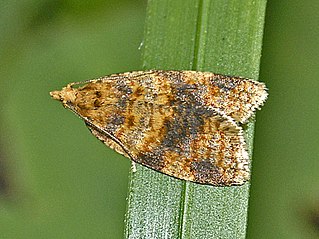
Epagoge grotiana, common name brown-barred tortrix, is a moth of the family Tortricidae, first described by Johan Christian Fabricius in 1781.

Epiblema foenella, the white-foot bell, is a moth of the family Tortricidae.

Isotrias is a genus of moths belonging to the family Tortricidae.
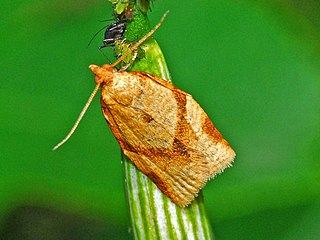
Clepsis consimilana, the privet tortrix, is a moth of the family Tortricidae.

Celypha aurofasciana is a small moth species of the family Tortricidae. It is native to Europe and the Palearctic but occurs in some other places as an introduced species.

Ditula angustiorana, the red-barred tortrix, is a moth of the family Tortricidae found in Africa, Asia, Europe and North Africa. Other common names are the fruit-tree tortrix and the vine tortrix. The moth was first described by Adrian Hardy Haworth in 1811.
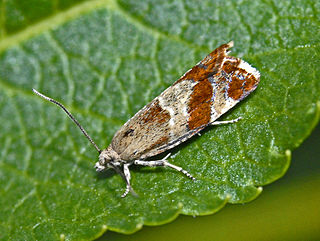
Epinotia cruciana, the willow tortrix, is a moth of the family Tortricidae.

Capua vulgana is a moth of the family Tortricidae found in Asia and Europe. It was first described by the German entomologist Josef Aloys Frölich in 1828.

Cochylidia rupicola, the chalk-cliff tortrix or conch, is a moth of the family Tortricidae.

Amblyptilia punctidactyla, also known as the brindled plume, is a moth of the family Pterophoridae found across the Palearctic. The species was first described by the English entomologist, Adrian Hardy Haworth in 1811.

Pandemis corylana, the chequered fruit-tree tortrix, hazel tortrix moth, filbert tortricid or barred fruit tree moth, is a moth of the family Tortricidae. It is found from northern and central Europe to Siberia, Korea and Japan.

Archips crataegana, the brown oak tortrix, is a moth of the family Tortricidae. It is found in most of Europe east to Japan.
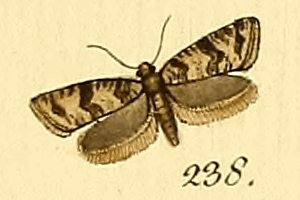
Isotrias hybridana is a species of moth of the family Tortricidae. It is found in France, Spain, Portugal, Italy, Germany, Poland, the Czech Republic, Slovakia, Austria, Hungary, Ukraine and most of the Balkan Peninsula.

Cnephasia longana, the omnivorous leaftier moth, long-winged shade or strawberry fruitworm, is a moth of the family Tortricidae. It was described by Adrian Hardy Haworth in 1811. It is native to western Europe. It is an introduced species in western North America. The species has also been reported from north-western Africa and Asia. The habitat consists of downland and rough ground.





















